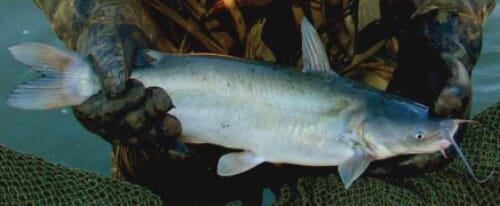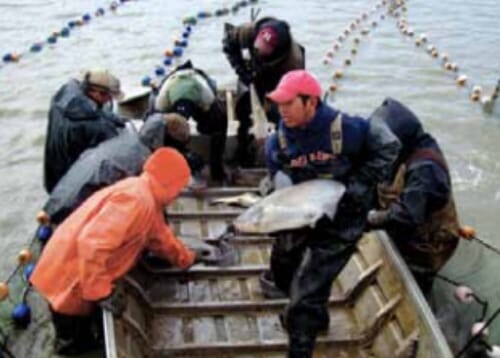The farm-raised catfish industry in the United States started in the late 1960s and rapidly grew to become the largest segment of the nations aquaculture industry, generating over 40 per cent of the total value of aquaculture production. More recently, however, competition from cheap imported fish has caused huge losses to catfish farmers. In general, the US catfish industry has stagnated during the last five years, and production has decreased by a third in an industry that was once doubling in size every decade. The industry is currently struggling to keep pace with increasing costs for feed and fuel, production inefficiencies and continued competition from foreign fish.
 |
| Pond testing has found hybrid catfish superior to channel catfish in growth, feed conversion, survival and days for production. Photo by E. Les Torrans. |
Hybrid Catfish
Channel catfish, Ictalurus punctatus, is
the most important catfish species raised
in the US. It has several desirable traits,
including rapid growth, ease of spawning,
tolerance to wide ranges of temperatures
and water quality, good product quality
and high consumer acceptance. However,
channel catfish have relatively non-uniform growth rates, are adept at evading
capture by seining and are susceptible to
species-specific diseases.
In the interest of increasing the efficiency of catfish production, channel catfish
females have been crossed with blue catfish
males to produce hybrid offspring.
Research and field trials have shown that
hybrid catfish have performance superior to
channel cats, with improved growth rates,
resistance to diseases, tolerance to stressors,
processing yields and ease of seining.
Fry Production
Open pond and pen spawning methods are generally unreliable means of hybrid fry production and are not suitable for commercial production. The largescale production of hybrids relies upon hormone induction and strip spawning of channel catfish females and artificial fertilisation with blue catfish males. Fully mature channel catfish females are ovulated by hormone treatments. Eggs are manually stripped and fertilised with macerated blue catfish male testes sperm solution. The fertilised hybrid eggs are water hardened and incubated in mesh baskets in catfish hatcheries. Hybrid fingerlings are raised similarly to channel catfish in production ponds.
History Of Hybrids
Harry Dupree first elaborated on the
techniques that facilitate channel catfish
and blue catfish hybridisation in 1966. The
channel x blue hybrid catfish is the only
hybrid among 28 interspecific hybrid
crosses and backcrosses evaluated within
the family Ictaluridae that exhibit dominant
traits desirable for intensive aquaculture.
In 2001, Gold Kist Aquaculture in
Inverness, Mississippi, USA, became the
first private hatchery to commercially
produce hybrid catfish, raising 2 million
fry in a season. US Department of Agriculture research grants stimulated interest
among commercial producers. In 2004,
Eagle Aquaculture, a subsidiary of Aetos
Technologies under Auburn University,
was formed to commercially produce
hybrid catfish.
In 2011, six catfish hatcheries in Mississippi and Arkansas produced an estimated 111 million hybrid fry. If these
estimates were correct, hybrid fry constituted 15 per cent of the 732 million channel catfish fry produced in 2011. Hybrid fry
production is projected to exceed 200
million by 2014.
 |
| Sperm from blue catfish males like these is used to fertilise eggs stripped from female channel catfish to produce hybrid fingerlings. Photo by E. Les Torrans. |
Improved Performance
A study was initiated to compare
hybrid catfish and channel catfish production performance in replicated 4-ha
earthen ponds in a commercial catfish
production facility in Alabama. In
December 2002, channel and hybrid fingerlings weighing 40 to 43 g each were stocked at 14,500 fish/ha in 21 and 12
ponds, respectively, within an 11-day
period. The fish were fed 32 per cent-protein
commercial catfish feed to apparent satiation two to three times a week in the
spring (when water temperatures were
low) and once daily after temperatures
reached 25 C. A minimal dissolved-oxygen concentration of 2 ppm was maintained throughout the production period
with paddlewheel aerators. The fish were
raised until they reached a harvestable
size of 0.60 kg.
This large-scale pond study demonstrated the superior production of hybrid
catfish in earthen ponds. At the end of
the study, the mean production of hybrid
catfish was 30 per cent higher than for channel
catfish, survival was 19.3 per cent higher, and
feed conversion was 15 per cent lower than for
the channel catfish (Table 1). The production period to raise hybrid catfish to a
marketable size was 266 days much
shorter than the 403 days required to
produce marketable channel catfish in the
study. A 1.25 per cent improvement in fillet
yield for hybrid catfish was also observed.
Around 75 commercial farms have
raised hybrid catfish fingerlings in production ponds, and most have witnessed
the improved performance of hybrid catfish. With good management practices,
farmers can typically produce a singleseason crop of 0.73- to 0.91-kg fish with
higher yields of 3.6-6.8 mt/ha and feedconversion rations of 1.7 to 2.0.
Higher production yields reduce the
cost of production and help offset
increases in feed, fuel and transport costs
to sustain profitability.

Challenges
Although hybrid catfish have clearly demonstrated performance benefits, challenges to their wider adoption remain. Genetic improvements in the parent channel and blue catfish species could produce superior hybrids. There is need for cost-effective ovulating hormones to improve egg quality for greater hatching success, as well as optimised hatching and incubation procedures to reduce hatchery losses. In addition, disease, water quality and off-flavor problems persist in production ponds. In spite of these issues, however, US catfish farmers will likely increasingly adopt hybrid catfish in years to come.
April 2012
